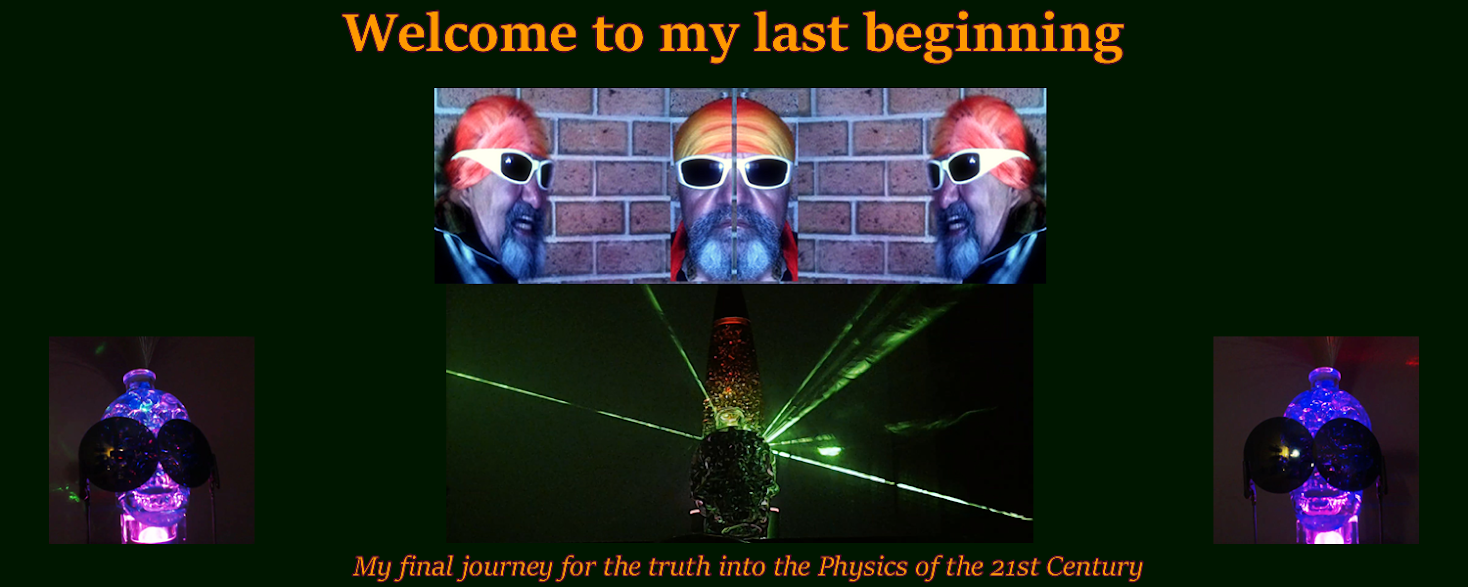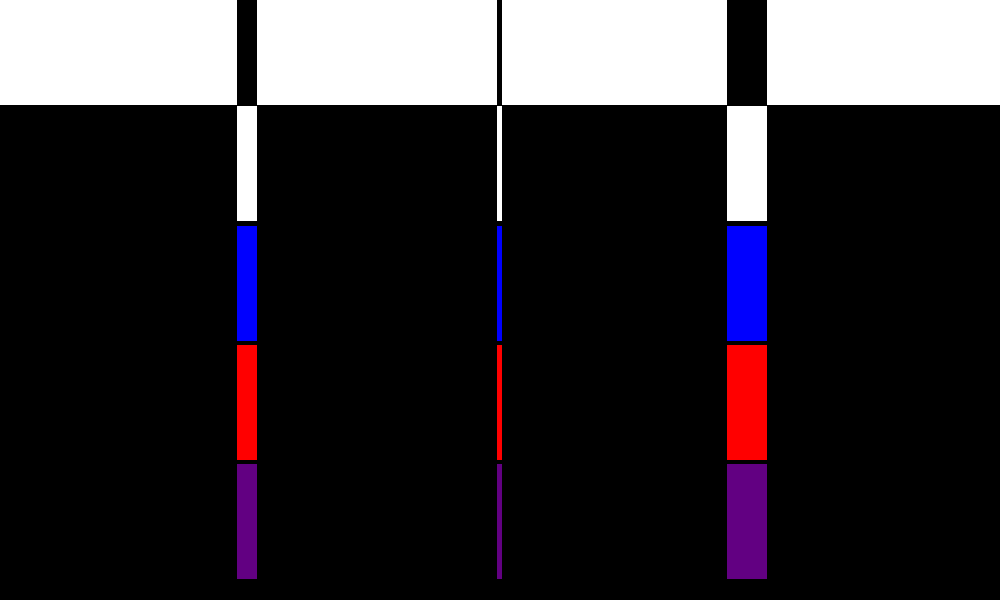The simplest things are hardest to discover. This truism is probably most evident in science, and I've been fortunate to become a direct eyewitness to one of its concrete manifestations.
For 350 years no one has managed to discover what was undoubtedly the most astonishingly obvious flaw in Newton's theory of light and colours. Not even Goethe managed to see it, and I have a very good reason for mentioning only his name out of many, many others. That very good reason I have is perfectly encapsulated in what is arguably the most popular artefact designed by Goethe in his long study of colours. See below.
On the right we can see the four spectral colours, which Goethe called boundary colours. They appear to an observer who looks at the figure with the four black and white rectangles through a prism that is oriented with the apex pointing down.
Now, without saying anything more than what I already have, can you see the flaw in Newton's theory that I have been talking about?
However lenient one may be with anyone, the reality is that even without a prism, anyone should not have too much trouble noticing that Red is 'looking' UP whilst Blue is 'looking' DOWN. How much easier should be to notice that, then, with a prism. One shouldn't even have to look through it at Goethe's diagram. Indeed, it would suffice to hold the prism in front of the figure, halfway along the middle line with the base up and apex down, for anyone to easily see then that Blue and Red extend in opposite directions. This is in stark contrast to Newton's view that all colours are bent, refracted, or deflected in the same direction by a prism.
And that is all that it should have taken anyone to spot what is in truth a major flaw in Newton's celebrated theory. As it stands, though, no one has managed to detect it in 350 years of intense research. Not even Goethe, as I said.
Have a good look at the two images below. The first contains a diagram that can fully verify, or otherwise falsify, the statement in the title when it is used in a subjective prismatic observation. Specifically, we'll be looking at it through an equilateral prism (oriented with the apex towards the left) from a distance of about 50cm. When one does that, one sees the first image transformed into the second one below it. Moreover, if one claims that one knows what's going on in that transformational process then one ought to provide a concrete and coherent explanation for every single spectral item that is visible in the second picture. Otherwise, one has obviously no idea about what causes those features.
According to the significant experience that I have accumulated on that topic over the years, there is a strong possibility that there isn't another person able to do what is required in that matter. Another person than myself, that is.
We begin by explaining the reason for the black and white bars that are sitting above those three columns of colours under scrutiny. The reason for my putting them there is the fact that they provide precise points of reference relative to which we can monitor whether the G, C and Y rectangles are deflected from their original positions by the prism.
Now, let us look at the top of the middle column, which has a narrow black bar in the first image and in the other the trio of colours that is also called the Goethean spectrum: Y, M, C. This, sometimes called inverse spectrum, is generated by the white background upon which the black bar in the first image rests. The narrow black bar is not seen in the second picture because it has been covered by the overlapping of R and B, with B coming from the white field on the right of the black bar, and R from that on the left. As we know, R is deflected in the direction towards the base of the prism, and B in the opposite direction, towards the apex. Together they form M, which is exactly as wide as the black bar. Y appears on the left of M, at a relatively large distance. C is on the right of M and much closer to it. All three appear to have the same width. And now we are at my favourite part of the explanation for this case. My favourite because I have good reason to believe that no one, beside me, knows what the correct answer must be to the following question: What is the reason for the gaps between the three complementary colours?
The reason is the fact that the two spectra generated by the white background are not only deflected upon observation. They have also much larger widths, which when in combination with the deflection increases the overall effect. In fact, the widths of the colours in this case are the same as those of their counterparts from the other two columns. That's easily verifiable. It is only the distance between observer and subject that determines the widths of the spectral colours, as you can readily see when looking at those two counterparts I had mentioned earlier. And this fact tells a different story for those gaps between the colours than one may believe. The four spectral colours (Y R B and C) overlap on larger areas than we may be led to believe, which leads to two inevitable situations: R to overlap C, and B to overlap Y. Both situations create white patches, hence...
Before getting into the next case, it is very important to realise that a subjective observer can understand quite a lot more of the subject when every observation conducted involves not only observation from a distance, but also observation of all points of reference along the perpendicular axis. For those who do not really know what I am talking about, it means observation conducted in the following manner. Place yourself at a distance from the monitor that is roughly an arm extension away. Hold your prism with the apex pointing to your left and look carefully at the image in front of you. When satisfied, begin taking the prism very slowly away from your eye towards the monitor. There's no need to immediately try to follow the prism, you can get a good perspective from where your head is, for the time being. Finally, in order to see clearly how the unfolding of the entire phenomena evolves, you can place your eye close to the prism, which is practically touching the screen, and repeat the process, in reverse.
Let us look next at the RGB spectral trio right below in the middle column. Here we can see that the G component of the spectrum is perfectly lined up with the M, which means therefore that G has not been deflected at all from its original position. That also means that R had been deflected by the prism in a direction towards its base, and that B had been deflected in the opposite direction. There is no other way. And the most beautiful part of all this is that anyone can literally see how that happens simply by looking through their prism (apex to the left) at the narrow white bar that generated the RGB bars, while moving slowly the prism closer and closer to the monitor.
Staying with the middle column, the next spectral display is that generated by the G bar. There is not much to notice here, except that the G component is most dominant, with only very narrow bands of R and B barely showing on each side of the G bar. One particular thing is worth mentioning in this case, however. That is that R and B are always projected onto the (black) background. In other words, they are never encroaching into the original width of the light source.
The next item we'll scrutinise is one of the most interesting in our entire panoply of spectra. Looking subjectively at the C bar in the middle column, we observe that from our distance of 0.5 m the original C bar appears to be perfectly G! At a first glance this might seem like a most surprising occurrence. A closer inspection, however, reveals that there is nothing exceptional about that. Looking carefully at the C bar whilst moving the prism closer and closer to the screen shows us why from a distance the C bar appears G. The B component of C is increasingly deflected towards the apex of the prism, leaving behind the other component of C, which is of course G. (Although this is basically what happens in this case we shall return to this subject very soon, for there are still a number of very important implications that need to be discussed.)





